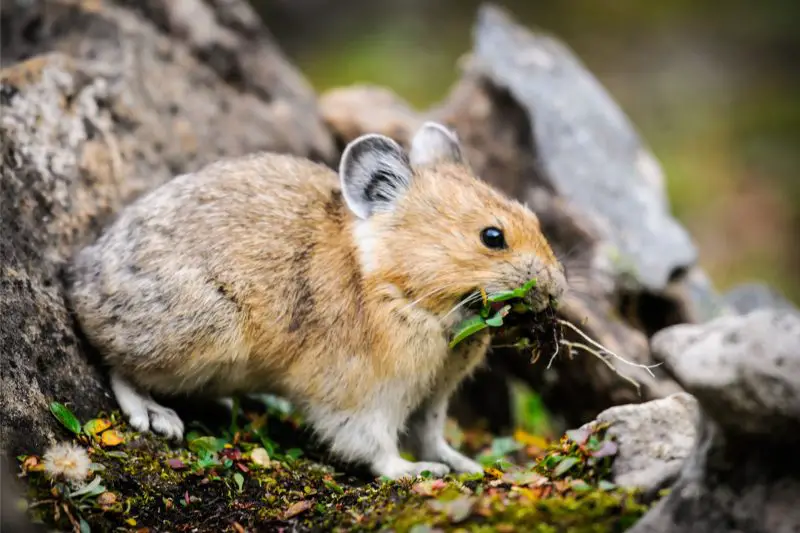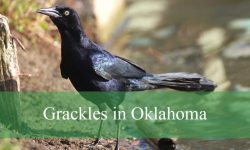Nestled among the rugged peaks and alpine meadows of Colorado, a small yet captivating mammal thrives in the high elevations—meet the American pika (Ochotona princeps). Often mistaken for rodents due to their size and appearance, pikas are actually lagomorphs, closely related to rabbits and hares. These alpine dwellers are not only adorable but also play a crucial role in their ecosystems.
This guide delves into the fascinating world of pikas in Colorado, exploring their identification, behavior, diet, habitat, distribution, and some fun facts that make them truly unique.
Identification and Physical Characteristics

Pikas are small, compact mammals with a distinctive body shape that sets them apart from other alpine wildlife. Their bodies are stout and slightly rounded, designed to conserve heat in the cold, high-altitude environments they inhabit. Their limbs are short but strong, allowing them to move adeptly across rocky slopes and boulder-strewn terrain. One of the most noticeable features of pikas is their rounded ears, which are relatively large compared to their head size. These ears are covered with fine fur, helping to minimize heat loss while also giving them excellent auditory sensitivity to detect predators or the calls of neighboring pikas.
In terms of size, pikas generally measure between 7 and 8.4 inches (18 to 21 cm) from nose to rump and weigh between 5.3 and 6.2 ounces (150 to 175 grams), making them comparable in size to a guinea pig. Despite their small stature, they have a surprisingly muscular build, which supports their agile climbing and jumping abilities on steep, uneven surfaces. Their fur is dense and soft, ranging in color from light gray to brown, often with subtle variations that blend perfectly with the surrounding rocks and alpine meadows. This natural camouflage is critical for evading predators such as weasels, owls, and foxes.
Unlike many other small mammals, pikas do not have a visible tail, which contributes to their rounded, almost ball-like appearance. Their compact tail and body design help them maintain body heat in cold climates, while their large, expressive eyes and ears allow them to remain vigilant and responsive to environmental changes. Together, these physical adaptations make pikas uniquely suited to survive and thrive in the challenging alpine ecosystems of Colorado.
Behavior and Activity Patterns
Pikas are diurnal creatures, which sets them apart from many other small mammals that are primarily nocturnal. Being active during the day allows pikas to efficiently forage for food, socialize with neighboring pikas, and maintain their territories. Their activity patterns are closely linked to temperature and weather conditions; they tend to be most active during the cooler morning and late afternoon hours, avoiding the midday heat that can be dangerous for them due to their sensitivity to high temperatures.
These small mammals are incredibly agile and adept at navigating rocky alpine terrains. They dart nimbly among boulders, using their strong limbs and sharp claws to maintain balance on uneven surfaces. Pikas often perch on prominent rocks to survey their surroundings, monitor for predators, and communicate with other pikas. Vocal communication is a defining feature of pika behavior. Their distinctive, high-pitched whistles or “mews” serve multiple purposes: warning nearby pikas of predators, establishing territorial boundaries, and attracting mates during the breeding season. The intensity and frequency of these calls can vary depending on social interactions, environmental stressors, and time of day.
During the harsh winter months, pikas remain active despite the freezing temperatures. They rely on tunnels beneath the snow, rocks, and talus slopes to navigate safely and access their haypiles. This subterranean movement is essential not only for foraging but also for thermoregulation, as the snow provides insulation from extreme cold. Their ability to maintain activity in winter highlights their remarkable adaptation to the alpine environment, demonstrating resilience and careful energy management.
Diet and Foraging Behavior
Pikas are strictly herbivorous, feeding on a variety of plants available in their high-altitude habitats. Their diet consists of grasses, sedges, mosses, wildflowers, and occasionally the tender leaves of shrubs. Pikas are known for their extraordinary foraging strategy called “haying,” a behavior where they collect and store vegetation for the winter months. Throughout the summer, they gather plant material and meticulously arrange it into haypiles—small stacks of dried plants hidden in rock crevices or under boulders. These haypiles are critical to their survival, as pikas do not hibernate and must rely on these food caches when fresh vegetation is unavailable.
The haying process is both labor-intensive and time-sensitive. Pikas must work efficiently during the warm months to gather sufficient plant material to sustain themselves through the long, cold winter. The selection of plant species for haypiles is strategic: pikas often choose plants with higher nutritional value and longer shelf life to maximize their survival chances. Their foraging behavior also plays a role in shaping the alpine plant community, as selective feeding and transport of seeds contribute to plant dispersal and ecosystem dynamics.
Interestingly, pikas exhibit territorial foraging behavior. Each pika maintains a specific area around its home base, guarding its haypiles against intruders. This territoriality ensures that stored resources are available when needed, and it reduces competition among neighboring pikas. By observing a pika at work, one can witness the intricate balance between resource management and survival strategy that has evolved over millennia.
Habitat and Distribution in Colorado
In Colorado, pikas are primarily found in high-elevation alpine and subalpine regions, typically above the tree line at elevations exceeding 8,000 feet (2,400 meters). They thrive in environments characterized by talus slopes—fields of broken rocks—where boulders and crevices provide shelter, protection from predators, and spaces for storing haypiles. Pikas also inhabit alpine meadows and rocky ridges, which offer abundant foraging opportunities and access to diverse plant species.
Pikas are widely distributed across Colorado’s mountain ranges, including the Rocky Mountains, the Front Range, and the San Juan Mountains. These small mammals are especially common in protected areas such as Rocky Mountain National Park, where their habitats remain relatively undisturbed. The presence of pikas in these regions serves as an indicator of a healthy alpine ecosystem, as they require a stable, cold environment and sufficient vegetation to survive.
Visitors to Colorado’s highlands can often spot pikas by their characteristic whistles echoing across rocky slopes or by observing their quick movements among boulders. Summer months are ideal for observation, as pikas are most active when gathering food and maintaining their haypiles. The combination of their unique behaviors and stunning alpine habitats makes them a favorite among wildlife enthusiasts and researchers alike.
Reproduction and Life Cycle
Pikas reproduce primarily during the spring and early summer, taking advantage of the short alpine growing season to raise their young. A typical female pika gives birth to a litter ranging from one to four offspring, which are altricial at birth—they emerge blind, hairless, and entirely dependent on maternal care. The young grow quickly, gaining fur and mobility within a few weeks, allowing them to explore the surrounding talus slopes and learn essential survival skills.
The rapid development of pika juveniles is crucial for survival in high-altitude environments, where winters are long and harsh. By the end of summer, the young are sufficiently mature to forage independently and begin contributing to the collection of haypiles for the upcoming winter. Pikas generally reach reproductive maturity within one year, ensuring that populations remain stable despite the challenges posed by their alpine habitats.
Pikas exhibit a high degree of parental investment. Mothers not only nurse their young but also guide them in foraging and warn them of predators. Territorial behavior plays a significant role in reproduction, as securing a high-quality home range ensures access to abundant food resources for raising a litter. This combination of rapid growth, parental care, and careful territory management allows pikas to thrive in an environment that few other mammals can endure.
Fun Facts About Pikas
Pikas are fascinating creatures with several unique traits that set them apart from other small mammals. Despite their small size and rodent-like appearance, pikas are not rodents; they belong to the order Lagomorpha, making them close relatives of rabbits and hares.
These alpine dwellers maintain an unusually high resting body temperature of around 104.2°F (40.1°C), an adaptation that allows them to withstand the cold winters of their mountainous habitats. However, they are extremely sensitive to heat, and prolonged exposure to temperatures above 77°F (25°C) can be fatal.
Pikas are also highly vocal animals, using their distinctive, high-pitched calls to communicate with members of their colony and to alert others of nearby predators.
In addition, they are fiercely territorial, defending their haypiles and the surrounding areas from intruders to ensure a reliable food supply throughout the year. These remarkable behaviors and physiological adaptations highlight the pika’s resilience and its specialized role in alpine ecosystems.
Conservation and Climate Change
Pikas are considered an indicator species for climate change due to their sensitivity to temperature fluctuations. As temperatures rise, pikas are forced to move to higher elevations to find suitable habitats. This upward migration is limited by the availability of suitable terrain and food sources, making pikas vulnerable to habitat loss.
In Colorado, conservation efforts are underway to monitor pika populations and protect their habitats. Researchers are studying pika behavior, distribution, and genetic diversity to better understand the impacts of climate change and to develop strategies for conservation.
Where and When to Spot Pikas in Colorado
If you’re eager to observe pikas in their natural habitat, Colorado offers several prime locations. The Rocky Mountain National Park is renowned for its pika populations, especially in areas above the treeline. Other notable spots include Mount Evans, Loveland Pass, and the San Juan Mountains. The best time to see pikas is during the summer months, from late June to early September, when they are most active and visible.
When searching for pikas, look for their distinctive calls and listen for their high-pitched whistles echoing across the rocky slopes. With patience and a keen eye, you might catch a glimpse of these delightful alpine residents.
Conclusion
The American pika is a remarkable creature that embodies the resilience and adaptability of life in Colorado’s high-altitude environments. From their unique foraging behaviors to their vital role in the ecosystem, pikas offer a glimpse into the intricate web of life that exists in the alpine regions.
By understanding and appreciating these fascinating mammals, we can contribute to their conservation and ensure that future generations can enjoy the sight of pikas darting among the rocks of Colorado’s majestic mountains.
FAQs About Pikas in Colorado
What is a pika and how is it different from a rodent?
A pika is a small mammal belonging to the order Lagomorpha, closely related to rabbits and hares. Unlike rodents, pikas lack long tails and have rounded ears and a compact body suited for alpine habitats.
Where can I find pikas in Colorado?
Pikas are commonly found in high-elevation areas above 8,000 feet, including the Rocky Mountains, San Juan Mountains, and alpine regions of Rocky Mountain National Park. Talus slopes and rocky ridges are their preferred habitats.
What do pikas eat?
Pikas are herbivores, feeding on grasses, sedges, mosses, and alpine wildflowers. They collect and store plant material in haypiles during summer to survive the winter when fresh vegetation is scarce.
How do pikas survive the winter?
Pikas do not hibernate. Instead, they rely on haypiles of dried plants stored in rock crevices. They remain active under the snow, using tunnels to access these food caches and stay insulated from the cold.
Are pikas endangered?
Pikas are not currently classified as endangered, but they are highly sensitive to climate change. Rising temperatures can reduce their suitable habitat, forcing them to move to higher elevations.
How do pikas communicate?
Pikas use high-pitched whistles and calls to warn of predators, establish territory, and communicate with other members of their colony. Their vocalizations are especially noticeable during summer months.
When is the best time to observe pikas?
The best time to spot pikas is during late June through early September, when they are actively foraging and maintaining haypiles in alpine meadows and rocky slopes.






